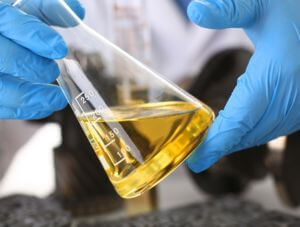Elemental analysis of industrial lubricants and oils: an overview

Elemental analysis and metal analysis of lubricants and oils play a crucial role in the modern global economy – including the automotive, aerospace, energy, and manufacturing sectors – by supporting optimal performance and failure analysis in equipment, as well as quality control (QC) and regulatory compliance. In this article, we discuss the key analytical techniques and testing methods for lubricants, challenges in metal analysis, the role of certified reference materials (CRMs), plus the importance of choosing the right CRM and diluent matrix solvent.
Four reasons why elemental analysis of industrial lubricants is performed
The detection and quantification of elements in lubricating oil, aviation oil, and industrial oil additives underpins a number of important operational objectives, including:
Performance Optimisation, as detection of wear metals and contaminants prevents equipment failure, enhances operational efficiency, and reduces maintenance costs.
Failure Analysis that helps to diagnose equipment issues and prevent future failures.
Quality Control (QC), because accurate measurement of metals can ensure the correct formulation to meet performance specifications.
Regulatory compliance, helping companies to demonstrate the integrity of their analytical results using standard test methods such as ASTM’s Petroleum Standards (see more below).
Key analytical techniques and testing methods for lubricants
Among the most widely-used techniques for elemental analysis of lubricants and oil additives are Inductively Coupled Plasma Optical (Atomic) Emission Spectrometry (ICP-OES, ICP-AES), Atomic Absorption Spectrometry (AAS), X-ray Fluorescence (XRF) Spectrometry, and Rotating Disk Electrode Optical (Atomic) Emission Spectrometry (RDE-OES, RDE-AES).
The global standards body ASTM International plays a vital role in establishing standard test methods for the analysis of petroleum products, which help to ensure the reliability and consistency of analytical results across the industry. ASTM also fosters collaboration among expert scientists, enabling its methods to remain relevant and widely adopted globally, and reinforcing the integrity of petroleum analysis and trade.
The four key ASTM Methods for metal analysis of lubricants and oils are:
D4927: Standard Test Methods for Elemental Analysis of Lubricant and Additive Components—Barium, Calcium, Phosphorus, Sulfur, and Zinc- by Wavelength-Dispersive X-Ray Fluorescence Spectroscopy (WDXRF)
D4951: Standard Test Method for Determination of Additive Elements in Lubricating Oils by Inductively Coupled Plasma Atomic Emission Spectrometry
D5185: Standard Test Method for Multielement Determination of Used and Unused Lubricating Oils and Base Oils by Inductively Coupled Plasma Atomic Emission Spectrometry
D6595: Standard Test Method for Determination of Wear Metals and Contaminants in Used Lubricating Oils or Used Hydraulic Fluids by Rotating Disc Electrode Atomic Emission Spectrometry
Metal analysis in action: the US Joint Oil Analysis Program
Metal analysis is a cornerstone of the Joint Oil Analysis Program (JOAP), an initiative led by the United States Department of Defense to monitor and maintain the health of military equipment through the analysis of lubricating oils and other fluids. Using the RDE-AES method, JOAP detects and monitors wear and contamination across a wide range of machinery critical to military operations. By analysing trace metal particles in these fluids, the programme provides valuable insights into the condition of mechanical systems. This predictive maintenance approach has significantly enhanced safety, operational efficiency, and equipment longevity in defence operations.
LGC Standards – your trusted partner in oil and lubricant analysis
For decades, LGC Standards companies have been trusted to provide the high-quality reference materials that leaders in heavy machinery, railways, aerospace and the military rely on worldwide to support their elemental and metals analysis of lubricants and oils.
Our VHG brand has more than 40 years’ experience in manufacturing high-purity single and multi-element calibration standards for spectroscopic instrumentation, including:
We also have the ideal solvent and diluent standards for your requirements:
Our VHG and Paragon ranges meanwhile feature a number of related products for petrochemical analysis – such as sulphur and physical property standards, plus rapid feedback oil proficiency testing schemes.
You can also download our Oil Condition Monitoring catalogue to browse our full offer.
|
Challenges in metal analysis of lubricants and oils
Metal analysis of lubricants and oils presents several challenges, due to the complex composition of these materials and the trace levels at which metals are often present. The table below summarises some of these key challenges.
| Challenges | Solutions |
|---|---|
| Contamination Risks | Adopt strict laboratory protocols, including the use of high-purity reagents, clean equipment, and contamination-free workspaces |
| Detecting Low Concentrations | Use highly sensitive methods for accurate trace metal analysis |
| Complex Matrix Effects | Implement proper pre-treatment methods |
| Matrix-Specific Calibration Challenges | Utilise matrix-matched Certified Reference Materials (CRMs) Use high quality diluent matrix solvent |
| Stability of Metallo-Organic Standards | Use a diluent solvent that is effective at stabilising the metals Minimise exposure to moisture or high humidity |
Choosing the right Certified Reference Material and diluent matrix solvent
Accurate and reliable metal analysis depends on more than just the right analytical method and good laboratory practices. It also hinges on two important factors: using high-quality Certified Reference Materials (CRMs) for calibration and control standards, and selecting a suitable diluent matrix solvent. These components work together to deliver accurate data and ensure regulatory compliance in petroleum product analysis.
Calibration and control standards must remain stable and homogeneous during use to ensure consistent and accurate analytical results over time. Additionally, they should closely match the sample matrix to minimise matrix effects, thereby improving measurement precision and reliability. True CRMs provide the highest reliability and confidence, especially those produced under ISO-accredited systems like ISO 17034. Available in practical formats such as multi-element metallo-organic analytes in base oil matrices, these CRMs ensure consistent, accurate results for calibration and control standard.
Laboratories may use a range of solvents depending on availability and requirements, including reagent-grade xylene and locally sourced options such as lamp kerosene or white spirits. While these solvents may effectively dissolve certain samples, variations in impurity levels and stability can result in variability of analytical test data. It is therefore essential to use high-quality, consistent solvents to minimise variability and ensure reliable outcomes. For example, V-Solv™ ICP solvent is a proprietary solution designed specifically for diluting oils and other organic liquids for analysis using techniques like ICP-OES and ICP-MS, and provides exceptionally stable dilutions of metallo-organic standards and oil samples.
Get more from LGC Standards



